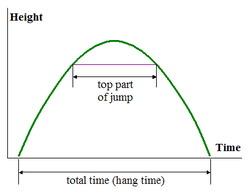
1
Jumping for basketball, throwing and leaping for a slam dunk, the human body follows the principle of projectile motion. text source
Projectile motion is the motion of an object thrown (projected) into the air when, after the initial first force that launches the object, air resistance is negligible unseen and the only other force that object experiences is the force of gravity. The object is called a projectile, and its path is called its trajectory.
2
2
A basketball player can jump as much as 4 feet in the air .... .
3
And the higher he jumps the greater the hang time (the total time he is airborne), and the greater the time he will appear suspended in mid-air during the high point of the jump.
4
4
. . . there is a horizontal and vertical component in the jump velocity speed in a direction at take-off.
(That's scientific text for jumping at an angle! They all do it!)
5
The magnitude strength of the vertical upright component of the velocity at take-off will determine decide the time the player spends airborne (since gravity acts in the vertical direction and will act on the player to bring him back down).
6
Thus, the vertical component bit of velocity, after take-off, will change with time.
7
7
The horizontal component part of velocity remains constant the same throughout the jump since it is not affected by gravity.
Go back to the added text at 4.
8
The figure below shows how a basketball player might travel as he makes a jump.

You can see that almost half the hang time is spent near the top of the arc.
9
The ball

- The Basketball, during a free throw, is a projectile. A projectile is any object fired, thrown, or otherwise propelled.
- A basketball relates to a projectile as the force exerted upon the basketball is a push.
- The basketball is then projected aimed horizontally level and vertically, causing, if the proper shooting technique is applied, the basketball to rotate, elevate rise, and finally swish through the net.
- The horizontal and vertical components are both independent operate separately, and therefore do not effect each other.
- The arch caused by the basketball is a result of the gravitational pull upon the basketball, and if a basketball was thrown without a gravitational pull acting upon it, the basketball would travel continuously without arching (this also relates to Newtons 1st law).
- Therefore, playing basketball in space would be an absurdity stupid.
10 Motion the original text says Motions
Vertical-Launched Projectiles
As mentioned above, projectiles not only undergo experience - go through a vertical motion, but also undergo a horizontal motion and these perpendicular at right angle components of motion.. are independent separate from of each other, which are discussed separately.
11
11
- When we have a ball in our hand, and we release it and let it fall to the ground (with gravity), it's the vertical motion, and it will continuously travel downwards until it hits something or the ground.
The universal gravitational constant is the gravitational force acting between two bodies of unit mass*, kept at a unit distance from each other. The value of G is a universal constant and doesn't change. source
*What is the force between two bodies of mass?Gravitational force -an attractive force that exists between all objects with mass; an object with mass attracts another object with mass. source
------------------------------------------------------------
Galileo found that gravity imposes a constant acceleration on all objects regardless of mass. That is, no matter how large or small an object is, it will fall at the same rate of acceleration. On Earth this acceleration is 32 feet (9.75 meters) per second per second. Thus, at the end of one second, a falling object is moving at a rate of 32 feet per second; at the end of two seconds, it is moving at 64 feet (19.5 meters) per second, and so on. source


No comments:
Post a Comment